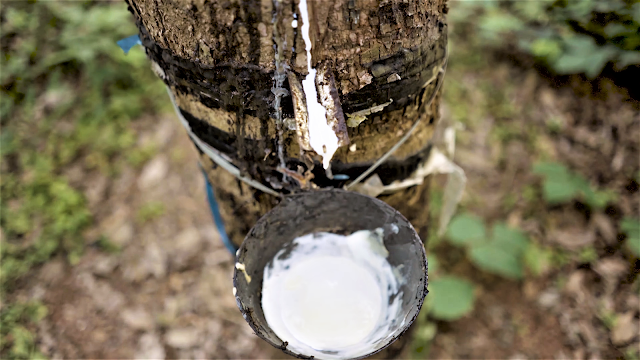Latex, also called rubber, is obtained from the milky sap of the rubber tree and has become one of the most common materials for the textile, medical and motor industries.
 |
| What is latex made from?. |
Latex, also known as rubber, is a natural polymer obtained from the milky sap of the rubber tree (Hevea Brasiliensis), a plant native to the tropical forests of Central and South America.
There are other tree species in Asia (Osceola elastica) and Africa (Funtumia elastica) from which it is also possible to obtain rubber, but the largest production worldwide takes place on the American continent.
How do you make rubber out of SAP?
The sap from which the rubber is obtained has a whitish appearance and a semi-liquid texture with high density. Although this can be confused with a plastic derivative, it is 100% plant-based.
To obtain it, incisions are made in the shape of a V or spiral in the bark and the excess sap is allowed to flow until it falls into a previously placed bucket.
This practice is usually carried out when the plants are still young because this is the time when they produce the most sap. The "bleeding" is beneficial for the tree, since the sap we collect is a waste and when we remove it we get the tree to grow and regenerate faster.
What is natural rubber used for?
Its characteristics, including elasticity and transpiration, made latex applicable to many industries and sectors. Even in the case of school equipment, sports and textile industries, make-up, motors and medical devices, latex is one of the raw materials from which most use has been made.
Especially striking is its application for alternative medicines, as there are certain types of latex that have healing properties. However, it should not be forgotten that latex is often harmful to health and should therefore be used with caution.
Many medical products such as gloves, masks, catheters or plasters are made from latex.
Historically, this polymer has been used by humans for more than 3,000 years. Mesoamerican people like the Aztecs or the Mayans.
Rubber history
In Europe, the French naturalist Charles-Marie de la Condamine introduced this substance after a trip to Ecuador in 1736 and brought it into the scientific society of the old continent.
Approximately a century later, Charles Goodyear dedicated all his fortune and years of research to discover the vulcanization of rubber. This process made the material harder and more resistant to cold, so it is still used as a base for making tires or condoms.
In the 19th century, a group of Spanish researchers discovered that natural rubber was made up of several hydrocarbon chains and the various properties that characterize it began to be described.
The interest in this material was such that, during the First World War, German chemists began to manufacture it synthetically from petroleum products and since then, this became the main raw material for obtaining rubber.
Post related to where does latex come from?. Examples of latex plants, what is latex made of? also what plants contain latex and uses of natural rubber.
Comments
Post a Comment
You are welcome to share your ideas and thoughts with us in comments!